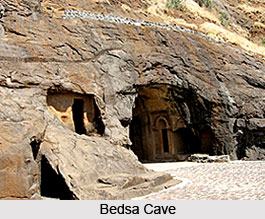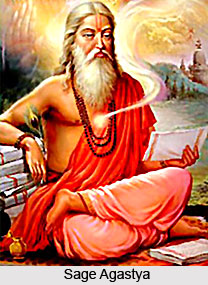 It has been believed that Aryan rishi Agastya crossed the Vindhyas and spread the Aryan culture to Southern India. Even today he is revered greatly in south. The various Dravidian kingdoms like the Pandya, Chola, Kerala, Pallavas, Andhras and Chalukyas in, have each left a rich legacy to the ancient culture of the south. After Ashoka, Deccan passed to the Andhras who ruled there for about four and a half centuries.
It has been believed that Aryan rishi Agastya crossed the Vindhyas and spread the Aryan culture to Southern India. Even today he is revered greatly in south. The various Dravidian kingdoms like the Pandya, Chola, Kerala, Pallavas, Andhras and Chalukyas in, have each left a rich legacy to the ancient culture of the south. After Ashoka, Deccan passed to the Andhras who ruled there for about four and a half centuries.
The Andhras patronised Sanskrit language. One of their kings, Hala, is believed to be a great poet who composed a poem consisting of seven hundred verses on love, in the Maharashtri language. Toleration was the great feature of their rule. Both Jainism and Buddhism flourished there. Temples were built. Buddhist monuments survived the proof being Amravati and Ajanta schools of art. The artistic genius of India manifested itself on a large scale in Southern India. The whole contemporary Andhra lives again in these Buddhist sculptures. Great realism is the characteristic feature of these sculptures.
In the Western Ghats one can see another kind of religious architecture, namely, the rock-cut caves which in this period were the Bhaja, Kordane, Ajanta, Bedsa, Nasik and Karli ones. In the Far South temple architecture is seen after the sixth century A.D.
 The Tamil kingdoms are first mentioned in a Sanskrit grammatical work. The main Dravidian languages are Tamil, Malayalam, Kannada and Telugu. Tamil is the oldest language and it also possesses the earliest vernacular literature of India other than Pali language. The oldest work that still survives is the famous grammar Tolkappiyam in Tamil. The great literary centre among the Tamilians was Madurai. Literary schools are said to have been developed there. The main themes of literature was hero-worship, love, devotion to duty, ethical teachings, honour and friendship. Tamil had its own epics, the Silappadikaram and its sequel the Manimekalai. These epics provide us with abundant details of social and artistic conditions of the ancient Tamilians.
The Tamil kingdoms are first mentioned in a Sanskrit grammatical work. The main Dravidian languages are Tamil, Malayalam, Kannada and Telugu. Tamil is the oldest language and it also possesses the earliest vernacular literature of India other than Pali language. The oldest work that still survives is the famous grammar Tolkappiyam in Tamil. The great literary centre among the Tamilians was Madurai. Literary schools are said to have been developed there. The main themes of literature was hero-worship, love, devotion to duty, ethical teachings, honour and friendship. Tamil had its own epics, the Silappadikaram and its sequel the Manimekalai. These epics provide us with abundant details of social and artistic conditions of the ancient Tamilians.
The Pallavas lost their supremacy when they had lost to the Chalukyas in the ninth century. Throughout this period the Tamilians continued to make cultural progress and their merchants plied their ships in all parts of the neighbouring seas, trading both with the eastern countries like Ceylon, Indonesia and Malaya and with the West till the Roman Empire. The articles that were exported were pearls, pepper and beryls. This trade became brisk with the establishment of the Roman Empire. In the ports there were settlements of foreign traders who were speaking their own languages.
 Alexandria was the main entry for Indian goods for Rome and other countries. People from that place flocked to India and colonists from other countries like the Jews, the Syrian and the Persian Christians and the Arabs. No foreign invasion took place till the 14th century in the southern part of India resulting in an integrated culture and even preserving the Aryan elements in the purest form.
Alexandria was the main entry for Indian goods for Rome and other countries. People from that place flocked to India and colonists from other countries like the Jews, the Syrian and the Persian Christians and the Arabs. No foreign invasion took place till the 14th century in the southern part of India resulting in an integrated culture and even preserving the Aryan elements in the purest form.
The people were prosperous and had their communal .governments. The land was the joint property of a group of landlords. In such villages an elected assembly and numerous communities looked after the affairs of the community as a whole. Women could also be members of such bodies that managed all departments of communal life. It is evident that people enjoyed many opportunities for self expression.
In the realm of art, temple building became the most prolific artistic creation. Temples were endowed with money and lands for their maintenance. Intricate management grew up as temples grew into temple-cities with each such unit having their priests, managers, treasurers, musicians, singers and so on. Schools and colleges were often attached to these places.
As far as religions are considered, Buddhism died out in most places by the end of the 6th century. Jainism had a stronger hold. Hinduism though was still the dominant religion. The Bhakti form of Hindu religion was a great vogue in the South.
The south Indian culture contains elements of the best features of India`s ancient heritage in the purest form. The Dravidians have given great philosophers like Shankar, great products of artistic genius in the realms of dance and temple architecture. In the medieval period they kept intact the products of Aryan thought and culture, thereby preserving for the generations to come the bases of Indian culture.



















